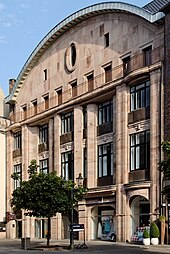Volkshaus Düsseldorf
The Volkshaus in Düsseldorf , Flinger Strasse 11, was built from 1907–1909 according to plans by Carl Moritz in the monumental style of reform architecture .
history
The client was Volkshaus-GmbH , which was founded specifically for the construction. It was an office and assembly building for the trade union and labor movement in Düsseldorf. At the same time it was the first house of the Düsseldorf workers' movement organized in a social democratic and free trade union. The district management of the General German Trade Union Federation for Rhineland and Westphalia-Lippe ( ADGB ), headed by Hans Böckler, as well as other union institutions with offices and conference rooms, a restaurant and accommodation for journeymen sat here . The Düsseldorf SPD maintained the printing press of its own “Volkszeitung” in the Volkshaus, as well as several party offices.
The Volkshaus became the scene of the violent storming by the SA on May 2, 1933 in the course of the " seizure of power ". The offices were devastated, flags, books and documents burned in the market square. Hans Böckler was arrested in his office and taken into "protective custody". The Nazis confiscated the building. After the war, a furniture store and a jazz cellar bar were located here.
On October 11, 1963, the artists Konrad Lueg and Gerhard Richter organized the action and exhibition Living with Pop - a demonstration for capitalist realism in the building that was then used as the Berges furniture store . In 1991, the furniture store Berges was named as the user for the house.
architecture
There are five arcades on the ground floor . Above it rise two upper floors, the large window areas of which are structured in a colossal order by a few wall pillars. A monumental, arched gable rises above it .
literature
- Dietrich Scheibe, Margit Wiegold-Bovermann (Ed.): Tomorrow we will occupy the union houses. The smashing of the trade unions in Rhineland-Westphalia. Klartext-Verlag, Essen 2003.
- Bastian Fleermann, Hildegard Jakobs: rule of violence. The Nazis came to power in 1933 in Düsseldorf. Droste-Verlag, Düsseldorf 2013, ISBN 978-3-7700-1493-4 .
Individual evidence
- ↑ Jens Dirksen: When the painter star Gerhard Richter was still a rebel . , Article from July 23, 2013 in the derwesten.de portal , accessed on July 25, 2013
- ↑ The Breidenbacher Hof. A Düsseldorf legend, its art and its history. (Ed. by Hotel Breidenbacher Hof Düsseldorf on the occasion of its 175th anniversary) Düsseldorf 1991, p. 105.
- ^ Roland Kranz, Jürgen Wiener (ed.): Architectural Guide Düsseldorf. Dietrich Reimer, Berlin 2001, p. 12. (Object No. 15)
Coordinates: 51 ° 13 ′ 30 ″ N , 6 ° 46 ′ 23.6 ″ E
